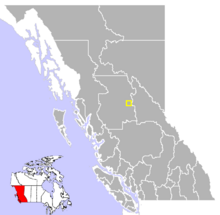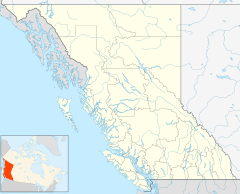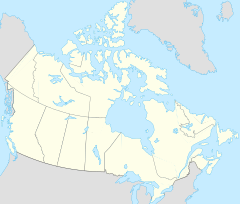Fort St. James facts for kids
Quick facts for kids
Fort St. James
|
|
|---|---|
|
District municipality
|
|
| District of Fort St. James | |
 |
|

Location of Fort St. James in British Columbia
|
|
| Country | Canada |
| Province | British Columbia |
| Region | Omineca Country |
| Regional district | Regional District of Bulkley Nechako |
| Founded | 1806 |
| Incorporated | 1952 |
| Area | |
| • Total | 23.47 km2 (9.06 sq mi) |
| Elevation | 700 m (2,300 ft) |
| Population
(2016)
|
|
| • Total | 1,598 |
| • Density | 72.0/km2 (186/sq mi) |
| Time zone | UTC−8 (PST) |
| • Summer (DST) | UTC−7 (PDT) |
| Postal code span |
V0J 1P0
|
| Area code(s) | +250, +778 |
| Highways | 27 |
| Waterways | Stuart Lake, Stuart River, Necoslie River, Nahounli Creek |
| Official name: Fort St. James National Historic Site of Canada | |
| Designated: | 1948 |
Fort St. James is a small town in central British Columbia, Canada. It's located on the southeastern shore of Stuart Lake. This town was once a very important place for trading furs.
Fort St. James is known for the John Prince Research Forest, which has lots of amazing wildlife. The community celebrated its 200th birthday in 2016! It's officially known as a district municipality.
Contents
Fort St. James National Historic Site
This historic site was first set up in 1806 by an explorer named Simon Fraser. He worked for the North West Company, which was a big fur trading business. Later, in 1821, another famous company, the Hudson's Bay Company, took over the fort. This happened when the two companies joined together.
Fort St. James was also called Stuart Lake Post. It's one of the oldest places in British Columbia where Europeans settled permanently. It was the main office for the Hudson's Bay Company's fur trading in a huge area called New Caledonia. The fort was rebuilt four times over the years. It stayed an important trading spot until the 1900s. Today, it's a National Historic Site of Canada. Some of its buildings are from the 1880s!
History of Fort St. James
In the early 1800s, Simon Fraser and his team, including John Stuart, explored new river routes to the Pacific Ocean. In the winter of 1805-1806, they found Stuart Lake. This area was home to the Dakelh First Nation people. It was a great spot for trading furs. So, in 1806, Fort St. James was built on the lake's shore.
When the North West Company and the Hudson's Bay Company merged in 1821, the Hudson's Bay Company took control. Fort St. James became the main office for their large New Caledonia fur trading region.
At first, the fur trade was a bit slow here. The Dakelh people traditionally focused on fishing, not trapping. Also, they had their own customs that affected how they traded furs. But over time, the fort became very successful. It kept running until it closed in 1952.
The town is located on the southeastern shore of Stuart Lake. The Stuart River also starts here. Both the lake and the river are named after John Stuart, Simon Fraser's assistant.
Climate and Weather
Fort St. James is in a special climate zone called the sub-boreal spruce zone. This means it has very cold, snowy winters. The summers are short and warm. This region is also full of different kinds of wildlife. The climate is known as a humid continental climate.
| Climate data for Fort St. James, 1981–2010 normals, extremes 1895–present | |||||||||||||
|---|---|---|---|---|---|---|---|---|---|---|---|---|---|
| Month | Jan | Feb | Mar | Apr | May | Jun | Jul | Aug | Sep | Oct | Nov | Dec | Year |
| Record high °C (°F) | 12.0 (53.6) |
13.0 (55.4) |
17.1 (62.8) |
24.4 (75.9) |
35.0 (95.0) |
33.9 (93.0) |
36.7 (98.1) |
35.6 (96.1) |
29.5 (85.1) |
26.5 (79.7) |
16.1 (61.0) |
11.0 (51.8) |
36.7 (98.1) |
| Mean daily maximum °C (°F) | −5.3 (22.5) |
−1.7 (28.9) |
4.0 (39.2) |
9.9 (49.8) |
15.6 (60.1) |
19.6 (67.3) |
21.8 (71.2) |
21.7 (71.1) |
16.4 (61.5) |
9.0 (48.2) |
0.6 (33.1) |
−3.8 (25.2) |
9.0 (48.2) |
| Daily mean °C (°F) | −9.5 (14.9) |
−6.8 (19.8) |
−1.8 (28.8) |
3.9 (39.0) |
9.2 (48.6) |
13.4 (56.1) |
15.4 (59.7) |
14.8 (58.6) |
10.2 (50.4) |
4.3 (39.7) |
−3.0 (26.6) |
−7.8 (18.0) |
3.5 (38.3) |
| Mean daily minimum °C (°F) | −13.7 (7.3) |
−11.8 (10.8) |
−7.7 (18.1) |
−2.2 (28.0) |
2.8 (37.0) |
7.2 (45.0) |
8.9 (48.0) |
7.9 (46.2) |
3.9 (39.0) |
−0.5 (31.1) |
−6.5 (20.3) |
−11.7 (10.9) |
−2.0 (28.4) |
| Record low °C (°F) | −49.4 (−56.9) |
−49.4 (−56.9) |
−39.4 (−38.9) |
−29.4 (−20.9) |
−11.7 (10.9) |
−6.1 (21.0) |
−5.6 (21.9) |
−7.8 (18.0) |
−13.3 (8.1) |
−23.0 (−9.4) |
−37.8 (−36.0) |
−47.2 (−53.0) |
−49.4 (−56.9) |
| Average precipitation mm (inches) | 48.1 (1.89) |
30.0 (1.18) |
25.7 (1.01) |
23.7 (0.93) |
38.9 (1.53) |
50.6 (1.99) |
50.6 (1.99) |
45.0 (1.77) |
39.3 (1.55) |
48.1 (1.89) |
44.5 (1.75) |
42.6 (1.68) |
487.2 (19.18) |
| Average rainfall mm (inches) | 4.9 (0.19) |
3.6 (0.14) |
5.9 (0.23) |
18.0 (0.71) |
38.2 (1.50) |
50.6 (1.99) |
50.6 (1.99) |
45.0 (1.77) |
39.1 (1.54) |
38.7 (1.52) |
15.7 (0.62) |
4.2 (0.17) |
314.5 (12.38) |
| Average snowfall cm (inches) | 43.3 (17.0) |
26.4 (10.4) |
19.8 (7.8) |
5.7 (2.2) |
0.7 (0.3) |
0 (0) |
0 (0) |
0 (0) |
0.2 (0.1) |
9.5 (3.7) |
28.8 (11.3) |
38.4 (15.1) |
172.7 (68.0) |
| Average precipitation days (≥ 0.2 mm) | 12.7 | 8.9 | 8.6 | 8.3 | 12.4 | 12.7 | 13.7 | 11.3 | 12.1 | 14.0 | 13.1 | 11.3 | 139.1 |
| Average rainy days (≥ 0.2 mm) | 2.0 | 1.8 | 3.2 | 6.8 | 12.2 | 12.7 | 13.7 | 11.3 | 12.1 | 12.4 | 5.3 | 1.8 | 95.2 |
| Average snowy days (≥ 0.2 cm) | 11.4 | 7.4 | 6.0 | 2.2 | 0.4 | 0 | 0 | 0 | 0.08 | 2.4 | 9.0 | 10.0 | 48.8 |
| Average relative humidity (%) | 81.6 | 72.6 | 57.0 | 45.0 | 44.1 | 48.0 | 47.3 | 47.7 | 52.7 | 62.9 | 79.8 | 84.2 | 60.2 |
| Mean monthly sunshine hours | 51.3 | 85.5 | 151.3 | 207.6 | 245.7 | 260.2 | 275.3 | 256.8 | 177.7 | 116.0 | 60.2 | 41.0 | 1,928.6 |
| Percent possible sunshine | 20.8 | 31.3 | 41.3 | 49.3 | 49.5 | 50.6 | 53.4 | 55.6 | 46.4 | 35.4 | 23.5 | 17.9 | 39.6 |
| Source: Environment Canada, (Sunshine and humidity data from Fort St. James Airport) | |||||||||||||
People of Fort St. James
In 2021, about 1,386 people lived in Fort St. James. The population has changed over the years.
The area around Fort St. James is home to many First Nations communities. These include Pinchie, Tachie, and Nak'azdli. About one-quarter of the people in the greater Fort St. James area are of First Nations background.
For a long time, Fort St. James also had a large community of South Asian people. Many were Punjabis who followed the Sikh faith. A Sikh temple, called Gursikh Temple, was built there in 1981. Over the years, many Sikh families moved to larger cities like Greater Vancouver. Today, the town is a mix of different cultures and backgrounds.
Famous People from Fort St. James
- Jim Playfair – He's an Associate Coach for the Edmonton Oilers in the NHL (National Hockey League).
- Larry Playfair – A former NHL player for the Buffalo Sabres and Los Angeles Kings.
- Dylan Playfair – An actor, best known for his role as "Reilly" in the TV show Letterkenny.
- Brian Spencer "Spinner" – A former NHL player.
- Chief Kwah (also known as Chief Kw'eh) – A very important Dakelh chief from the Stuart Lake area, who lived from about 1755 to 1840.
- Johan Pitka – An Estonian military leader.
Images for kids




